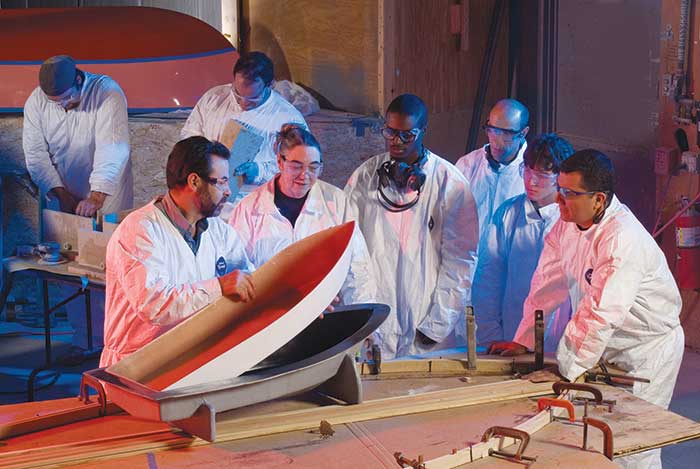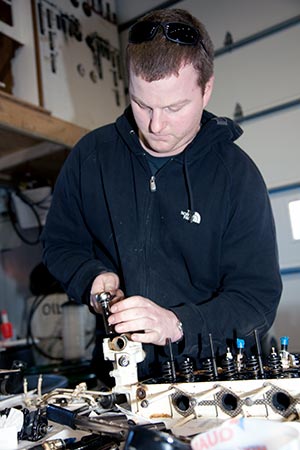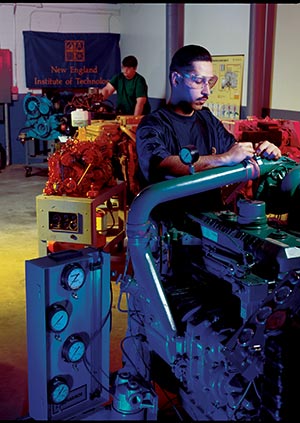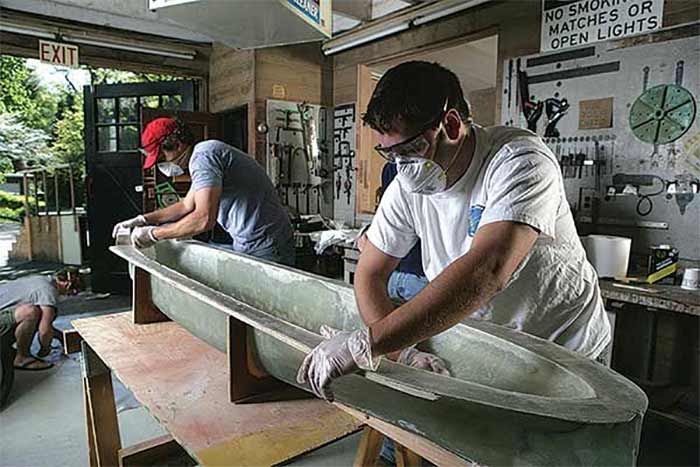Advertisement
This exclusive roundup of training schools that prepare future boatbuilders, repairers, and technicians for careers in the industry, where highly trained personnel are in demand.

A learning curve in hull design at the New England Institute of Technology, Rhode Island.
For anyone who has thought about a career in the marine trades — say, as a boatbuilder, designer, or marine technician — there's a world of top-notch one- or two-year technical programs across the country created to open a direct path to a lifelong career in and around boats. Trade schools, community colleges, accredited certification programs — these are the focus of this BoatUS Magazine roundup of post-secondary schools. Some offer state or industry certification; others, an associate's degree. Still others offer both.
In exploring these courses, we see a trend that promises two sustainable branches for growth: one for the person setting off on a new career in the marine industry; the other for the deliberate raising of the bar on standards-based work across the field. Together these trends promise to keep boat owners boating and marine trade professionals in steady demand.
NMEC: Your Best Friend In Marine Education
The National Maritime Education Council offers the best gathering of online resources for anyone already working or looking to work in the marine trades. In addition to the list of schools, you can also find an industry-wide skills analysis, job descriptions, and timely interviews with industry leaders. What drove NMEC's establishment several years ago, according to Council Chair Steve Kitchin, was the concern about overall labor supply. Yet even in a 13-percent-unemployment economy, he says, "the concern about skilled labor supply is still one that should be on the front burner for all employers. Most of the job losses that we've experienced aren't necessarily a perfect transition to a skilled labor supply for the marine world."
NMEC, together with the ABYC and Professional Boatbuilder magazine and a host of marine companies, has worked for several years now to help both sides of that equation: maintain the labor supply for employers, yes, but also cultivate successful lifelong careers out of what may have earlier been dead-end boatyard jobs.
Starting With Standards
Roger Hellyar-Brook envisions a different future for boatyards. It's a future in which the staff to whom boat owners entrust the care of their second-biggest investment no longer rely on on-the-job training and a hit-or-miss approach to repairs. It's a future no longer built on the promise that "your boat will be ready Friday," when everybody — customer and technician alike — knows that's not likely.
"I call it the Lexus model of customer service," says Hellyar-Brook. "When you bring in your Lexus for service, you're offered coffee in a clean waiting room with sofas and TV and magazines to read. If it's a longer project, they'll even give you a loaner car. It may be more expensive, but if you're told the vehicle will be ready on Friday, you'll get it on Friday. And it'll be fixed right."
Hellyar-Brook is a former merchant mariner from the north of England and it doesn't take long to understand that this is a man who knows his trade. For over a decade, Hellyar-Brook has directed and taught the marine-systems program at The Landing School in Arundel, Maine. In addition to marine systems, The Landing School also offers programs in wooden boatbuilding, composite boatbuilding, and yacht design.

A student at Skagit Valley College, Washington, gets ready to install a lower unit.
Listen as Hellyar-Brook describes what he calls the Trojan Project: "Every year, just before Christmas, we give the students their first big independent homework. They have to go aboard this 30-foot twin-engine gas cruiser and document every system: sani, potable water, fuel, engine, starting and charging, all the DC and AC wiring. Then they do schematics, diagrams, a parts list. Does it comply with standards or not in all the wire gauges and hose sizes? And what about the compatibility of materials?" With the merest wink, Hellyar-Brook says one more thing about this particular aging vessel: "It's very atypical."
In the late 1990s, The Landing School pioneered a yearlong marine-systems curriculum that hews closely to the standards laid out and adopted by the American Boat and Yacht Council (ABYC). In fact, Hellyar-Brook was disappointed when the standards body began offering open-book tests for certification; he'd been turning out students who carried the standards in their heads.
Since then, other trade schools across the country have worked even more directly with the ABYC to write curricula that are in line and up to date with the latest needs of the industry the students are being trained to enter.
Until about five years ago, the International Yacht Restoration School (IYRS, pronounced "iris") in Rhode Island was known exclusively for its two-year boatbuilding and restoration program, which focuses on historic wooden yachts. But after talking with marine-industry leaders, the school explored which skills the industry most needed. What resulted from those conversations was the first comprehensive marine-systems curriculum fully co-written with the ABYC. That nine-month program graduated its third class in June.

At work in systems class at the International Yacht
Restoration School in Rhode Island..
"We wanted to make sure of two things with this curriculum: that it's industry-based, and that it's written with both the standards and certification in mind," said Susan Daly, IYRS vice president of programming. "We wanted to both teach the standards and prepare anybody who goes through the curriculum to take the specific ABYC exams." This fall, IYRS added a nine-month composites technology program, also developed in close collaboration with industry leaders.
Both the IYRS and The Landing School offer "clock-hour" programs — students clock in at 8 a.m. and out at 4 p.m., five days a week, as they would on a work site. Historically, both schools have focused on intensive skills preparation leading directly to certification, although both have recently made agreements with nearby colleges to also offer degrees. Both schools attract students from all over the United States and abroad, with a mix of recent high-school graduates and mid-career folks.
The List: America's Marine Technical Programs
ABYC's Marine League of Schools* is comprised of post-secondary schools offering marine trade programs designated by ABYC's education department as meeting the needs of the marine service and/or manufacturing sector by providing ABYC standards-based educational programming.
- Alexandria Technical College (MN)
- Automotive Training Center (PA)
- Broward College (FL) *
- Cape Fear Community College (NC)
- Carteret Community College (NC)
- Cecil Community College (MD)
- Cedar Valley College (TX)
- Central Louisiana Technical Community College (LA)
- Chattanooga State Technical Community College (TN)
- College of the Albemarle (NC)
- The College of the Florida Keys (FL)
- EHOVE Ghrist Adult Career Center (OH)
- George Stone Career Center (FL)
- Grenada National Training Agency (GD) *
- Hennepin Technical College (MN)
- International Yacht Restoration School (RI)
- Iowa Lakes Community College (IA)
- Kingsborough Community College (NY)
- Kodiak College (AK) *
- Lake Washington Technical College (WA)
- Landing School (ME)
- Madison Area Technical College (WI)
- Marchman Technical Education (FL)
- Marine Mechanics Institute (FL)
- Maritime Professional Training (FL)
- Massasoit Community College (MA)
- McFatter Technical College
- Minnesota State Community and Technical College (MN)
- Motoring Technical Training Institute (MA)
- New England Institute of Technology (RI)
- North Dakota State College of Science (ND)
- North Georgia Technical College (GA)
- Northwest School of Wooden Boatbuilding (WA)
- Northwestern Michigan College (MI)
- Ocean County Vocational Technical School (NJ)
- Okaloosa Applied Technology Center (FL)
- Peninsula College (WA)
- Pinellas Technical Education Center (FL)
- Rappahannock Community College (VA)
- Santa Barbara City College (CA)
- Seattle Central Community College (WA)
- Skagit Valley College (WA)
- Suncoast Technical College (FL) *
- University of Hawaii, Honolulu Community College (HI)
- Westlawn Institute of Marine Technology (ME)
- Wisconsin Indianhead Technical College (WI)
- Wyotech (FL)
Two Career-Path Choices
If you're considering a marine technical school, you'll need to make two decisions. The first is which sector to train for — manufacturing or service. The second is whether to seek a certificate or a degree. The difference between training for manufacturing versus service comes down to how much of the curriculum teaches troubleshooting and problem-solving. The service sector obviously requires more of both, and it's during a recession that the distinction between the two becomes especially pronounced. "I've been through several economic downturns in the marine industry," said ABYC curriculum developer Ed Sherman. "I can tell you that in every instance, the service sector has always been the anchor that's held it all together in terms of jobs."

Students at the International Yacht Restoration School get to work on engine systems.
Recent information from schools bears that out. "Marine systems graduates are in the highest demand," said Nicole Jacques of The Landing School in June. "While new boats may not be designed and built in a poor economy, existing boats always need maintenance. Our marine systems program graduates often have several certifications and a broad, solid understanding of electrical, engines, plumbing, steering, etc., which makes them particularly valuable to employers in yards."
Daly at IYRS concurs. "We have seen particular strength in the service/maintenance and marina sectors. So our marine systems graduates have had good success in getting employed. There are pockets of growing demand in the restoration sector and again, our graduates have found jobs." The intensity of such clock-hour programs as described above focuses much of a student's attention on those problem-solving skills needed to service existing boats. It's also true that many students come in to these programs with degrees already in hand. "Half of our students already have college degrees when they arrive," said Daly.
But if you don't have a degree, your next big question is: certification or degree program? The big difference between them comes in the many general-education credits — English, math, social sciences — that students need in order to achieve an associate's degree. To get an idea of the proportion, IYRS's two-year boatbuilding and restoration program translates to one semester's worth of credits toward a two-year associate's degree from the Community College of Rhode Island.

Engine class at the New England Institute of
Technology, Rhode Island.
Steve Kitchin is the vice president for corporate education and training at New England Institute of Technology, as well as the chairman of the Marine Industry Training & Education Council (MITEC, see sidebar). "Every study that's been done about skills and the future of the American workforce," said Kitchin, "indicates that for long-term success, people who have degrees perform better in the labor market — both in terms of the options made available to them and in terms of their financial wherewithal."
If getting a degree is your biggest priority, programs affiliated with community colleges or universities may offer the most effective path. The key is to make sure the program you choose offers the course of study you want. For example, community colleges, by definition, reflect the needs of the region where they exist. So if you're looking for deep training in service, but you live in a region where boatbuilding prevails, you may want to look beyond the nearest school.
In an effort to promote the latest marine standards and mitigate local differences, ABYC (in collaboration with IYRS) launched in 2008 what it calls the Marine League of schools. Based on 13 modules — marine electrical, plumbing, fuel and water tankage, pumps, propane and natural gas, fire protection, steering, and others, with a healthy dose of troubleshooting throughout — the Marine League curriculum is now available at five community colleges around the country: The Boat School at Husson University in Eastport, Maine; Broward College in Miami, Florida; Honolulu Community College in Hawaii; Rappahannock Community College in Warsaw and Glenns, Virginia; and Skagit Valley College with a new facility in Anacortes, Washington. ABYC hopes to add a school in New England and the Great Lakes to its Marine League, according to Sherman.
"The beauty of the Marine League of schools is that we're now in the process of standardizing our instruction from coast to coast," said Skagit Valley's Mike Swietzer. "It's an even playing field now, and the workforce can intermingle wherever they choose to locate themselves. This is something that we've needed for quite a while."
Students at Skagit Valley in Washington state go through a core marine program in their first year, then specialize in the second year. "Our first-year program includes general boat studies, lofting, tools and safety, and engines. Students get a general knowledge of what the marine trades are all about, and in the first year, if they choose, they get their ABYC certification," Swietzer said. For their second year, students choose an area of specialization, ranging from boat production, boatyard repair, charter-boat repair, or independent employment. Gen-ed courses are designed to dovetail with each student's specialty.

Engineering students get hands-on at the Webb Institute in Glen Cove, NY.
To find out more about marine trades programs near you and around the country, the best source of information comes from National Maritime Education Council (NMEC).
Their website offers a comprehensive listing of training programs in the United States and abroad. Note that NMEC's list includes high school and post-secondary programs, as well as unaccredited programs geared more toward boat owners than aspiring marine professionals. Our version exclusively features U.S.-accredited post-secondary schools.
Accreditation by a well-regarded agency offers several advantages to prospective students. To achieve accreditation, schools need to demonstrate a solid track record, measured in graduation and placement rates, as well as the relevance of their curriculum. In many cases, it requires them to assemble an advisory board of leaders in the industry for which students are being trained. Perhaps most important of all, accreditation makes schools and their students eligible for such government financial-aid programs as Pell grants, Stafford loans, and others. Tuition for marine-technology programs, before financial aid, ranges from roughly $7,000 for Skagit Valley's two-year program to just under $20,000 for either IYRS's or The Landing School's 10-month programs, once you factor in tools and texts.
Earning Potential
For annual salaries, The Landing School tracks students after they enter the workforce and said entry-level boatbuilders tend to make low to mid-$30,000s; systems technicians tend to make high $30,000s to low $40,000s; yacht designers tend to make mid-$40,000s to mid-$50,000s.
The American Boat Builders & Repairers Association (www.abbra.org) compiles an annual Wage Rate Survey. The ABBRA report breaks wages down by marine-trade job and by region. To get an idea of the nationwide figures, an unskilled yard laborer in 2009 earned $16 per hour on average, with a range of $8 to $26. Mechanics earn an average hourly wage of $22; electronics technicians, $24; yard foremen, $24.75. A general manager can expect a median hourly wage of $36, with a range from $16 to $116.
Surveying The Horizon
As you browse the programs, ask yourself whether what you want to learn is close to home or worth traveling for. Or, if you don't want to leave home at all, check out such online programs as ProBoat E-training, sponsored by the publishers of Professional Boatbuilder magazine, or the distance-learning Westlawn program in yacht design, part of ABYC. By contrast, if traveling is exactly what you're after, try the marine technology program at Cape Fear Community College in Wilmington, North Carolina. "Our two-year technical program is unique," said department chair Jason Rogers. "All our students spent 32 days underway on our own dedicated training vessel, the 85-foot Dan Moore."
What you should look for from all these programs, though, is direct, hands-on learning. In the end, that's probably the biggest contrast between today's trade schools and four-year colleges. "I'm a product of a liberal-arts education," said Kitchin, "but the reality is, there weren't a bunch of employers telling my school what skills to give me in order to prepare me for the labor market. Here, we're not a research institution. We're a career institution." Indeed, if it's a career institution you're looking for, your world of choices has never looked better.
